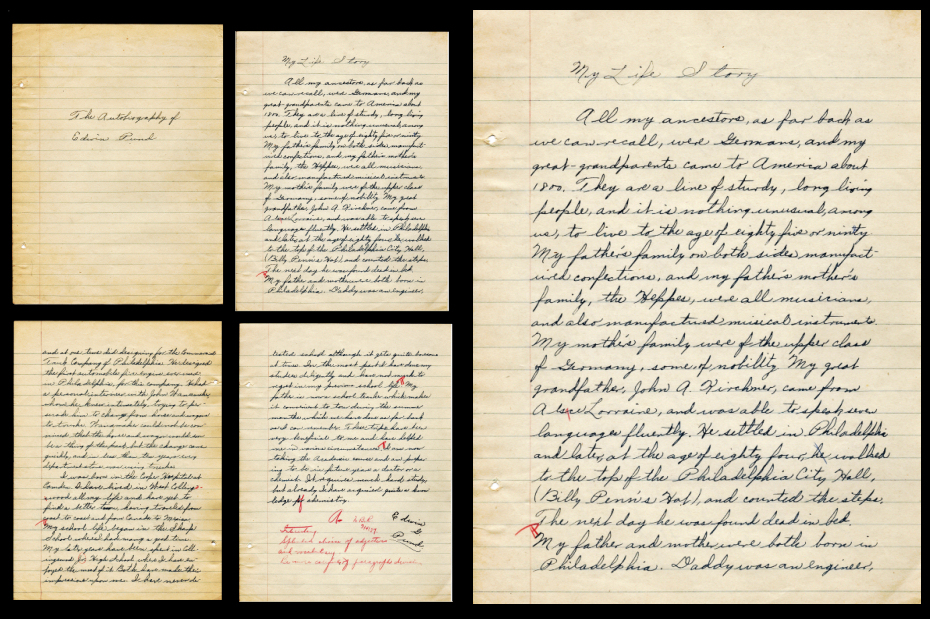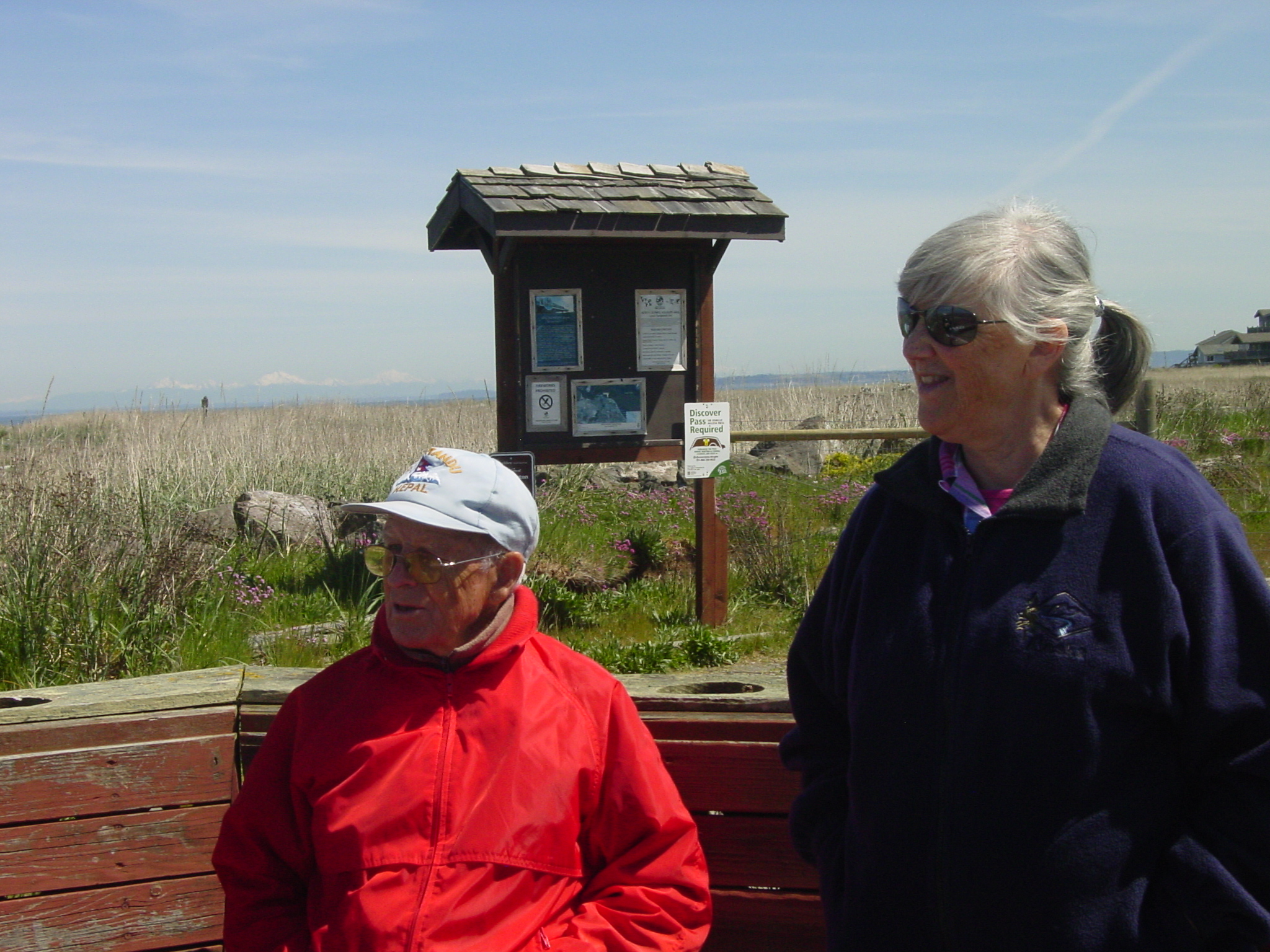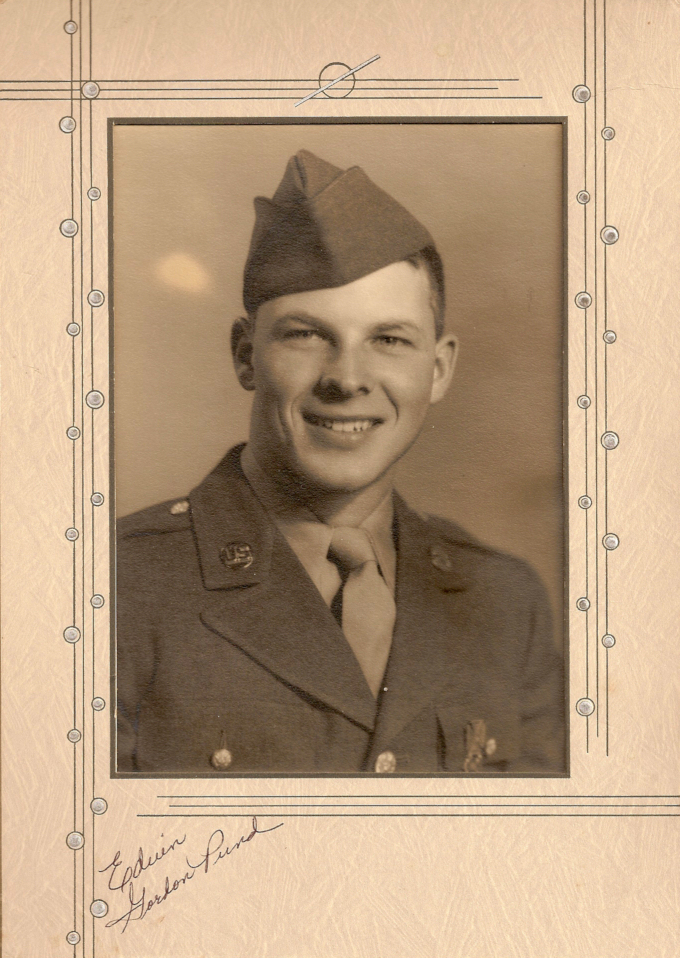[1]
This and subsequent footnotes have been added by me, Bruce
Crawford Duvall (b. 1943), Edwin’s nephew, son of Edwin’s
eldest sister, Frieda Josephine Pund (1910-2006), who
married my father Bruce Claxton Duvall in 1935, after which
she was known as ‘Jo’ Duvall.
[2]
Edwin Gordon Pund is my ‘Uncle Eddie’, with whom I stayed in
Seattle
for four months in 2014.
He is my mother’s kid brother, born 12 years after
her, in September, 1922.
He is now 93 and legally blind but more fit than an
old Stradivarius, with two rock-hard biceps that he loved to
invite people to touch on our recent auto trips around the
Northwest, any unsuspecting stranger with whom he struck up
a conversation. (He
was proud of his good health, partly achieved by exercising
even still in his nineties.)
He did not end up a ‘doctor’ or a ‘chemist’, as he
expected at 15 he might.
The Army and Air Force taught him aeronautics toward
the end of WWII and he studied it further at Drexel
Institute in Philly, but then, being the ‘baby’ of the
family and feeling lost for some reason, he didn’t know what
to do with himself. His
mother suggested he get a teaching certificate from Montclair State in New Jersey. Seeing he was
still lost after getting his Bachelor’s and certificate, she
suggested he go to Faith Theological Seminary for a
theological degree, which he did. He met Joyce
Simmons there and married her, then pastored a church in Arkansas,
where I last spent time with him in 1955 when I was 12: but
he found pastoring not to his taste either. (“American
churches today are a one-man show,” he complained recently
several times, meaning that the helpless and passive – and
barely believing – ‘congregation’ expects the preacher to do
everything.) After
that he taught high school science and band, but was thrown
out of every high school after just a year because, he said,
he always refused on diehard principle to join the teacher’s
union. Joyce
passed away about 1962, leaving him with four little kids, 8
to 2, whom he hauled all over the western states, moving
annually. Retired
for the last 20 years or more, and even though legally
blind, he spends his days weeding their big vegetable and
fruit garden with his daughter Marilyn and preparing for the
true calling he finally has found in his later years,
teaching his weekly Saturday morning Greek Bible class. For this, though
blind and 93 today in the fall of 2015, he draws upon his
scholarly knowledge of Biblical Greek (for which he was
given an honorary doctorate) and from his astonishingly
astute recall of hundreds – probably thousands – of Bible
verses which are
always precisely pertinent to the topic under
discussion.
He is an expert on the dozens of translations and
mis-translations of ancient Greek Biblical manuscripts, and
also is proficient in the very complex discipline of ancient
Biblical manuscripts, meaning which are authentic and which
not.
He told me, still sharp at 91, “Oh!
The Trinitarians [whom he considers ‘polytheistic’] use I
John 1:7-8 [First John chapter one, verses seven and eight]
to ‘prove’ that Jesus was God.
But Erasmus did not find those verses in the Greek
manuscripts he had available, and so he included only a
small portion of those two verses in his first two
translations of the New Testament from Greek, and his
translations were some of the first from Greek – after the
Dark Ages ended, and the Renaissance was beginning. But in his third
translation he included them, but only because the
(incorrectly Trinitarian) Roman church had called him on the
[red and papal] carpet and demanded they be included, and he
had said, ‘Fine, if someone can produce a Greek manuscript
that contains them, then I’ll include them, but the Greek
manuscripts that I possessed did not include them’; and some
monk in Ireland produced such a manuscript for him; and so,
in his third edition of his translation, Erasmus included
those two verses fully, as in the Irish monk’s Greek
manuscript; but that monk’s document was a forgery! Jesus was the
Messiah and he therefore talked constantly about his ‘father
in Heaven’. Which
means he was NOT GOD, he was a new kind of man, the
‘firstborn’ of many to follow, including us, as Paul says in
Romans 8:29...” etc., etc.
All of this with his 91-year-old brain and memory and
with his sight so impaired (by genetically inherited Macular
Degeneration) he can only read a print-out of a web page or
Bible page on a backlit flat screen of a reading machine
that is bigger than two microwaves, a viewing machine that
enlarges each tiny letter of Scripture to the size of a Big
Mac.
His name, ‘Edwin Gordon’, was given
him by his father (my maternal grandfather), Louis Luer
Pund, Sr. (born ca 1885), who named him after Louis’ best
friend, Eddie’s godfather, Edwin Gordon Stork; whom Evelyn
(my sister, b. 1939) and our South Jersey Pund (and Titzck)
cousins, Gini and Nancy (Gladys’ daughters), should remember
as ‘Dr. Stork’.
The Storks were not blood relations,
but remembering a little about them adds to an understanding
of the kind of people from whom my mother and her Pund,
Heppe, Myers and Kirchner forebears descended. And that is the
subject of this Post: what kind of
people the writer Duvall came from on his mother’s side
[note from editors: so we can comprehend him better and
maybe even sympathize, maybe even put up with
him and his crazy writing if it seems desirable – and/or
unavoidable.]
Louis Luer Pund (my grandfather) and
Dr. Stork knew each other at least since they were students
at Philadelphia’s Central High School, the student body of
which was hand-picked from the highest academic ranks of all
other Philadelphia public schools. Dr. Stork and
‘Aunt’ Grace and their daughter Phyllis were like family
through the years. Eddie
tells the story that whenever he was sick and especially
when he had scarlet fever at age 10 (and everybody feared he
would die or be left cardio-damaged for life), Dr. (Edwin
Gordon) Stork, Eddie’s namesake and godfather, would come
all the way over from his pediatrician’s office in Philly’s
Roxborough neighborhood, crossing the Ben Franklin Bridge
from Pennsy to South Jersey to see his best friend’s little
boy, and always would refuse payment whenever Eddie’s mother
(my grandmother, born 1886, died about 1956) offered to pay
him: “Now, Frieda, you know perfectly well I would never
accept payment from you!!”
The Storks were muckety-muck Episcopalians and their
daughter Phyllis, later valedictorian of her Women’s College
class at Penn (Univ.
of Pennsylvania),
eventually married the son of the Commandant of the U.S.
Marine Corps. When
I failed to get into medical school at the University of
Pennsylvania on the first round, my father (Bruce Claxton
Duvall, 1905-1986) persuaded Phyllis and another
Collingswood friend of the family who was a Penn
valedictorian from the Wharton (Business) School to write
extra last-minute letters of recommendation for me. He took the
glowing letters from these stellar Penn alumni in hand,
drove across the Ben Franklin bridge to West Philly and
Penn, and schmoozed with the admissions dean of the Medical
School
on several occasions, until finally I was accepted on the
second round, in August 1964, just a few weeks before
classes began.
In some ways I remember Dr. Stork
better than I remember my grandparents. My father would
drive us across the Ben Franklin Bridge (during the 40s and
50s), head out the East River Drive along the Schuylkill
River until the Drive petered out, then climb up Ridge Ave.,
which went curving upward and to the left quite steeply from
the narrowed Schuylkill, then park the big steel-heavy Buick
very carefully on the sharp incline. We would climb the
many steep and railinged stone steps way up to a Pennsylvania fieldstone (not brick)
big three-story Philadelphia
row house way above our heads.
Inside the front door on the right was Dr. Stork’s
mysterious office, with shiny steel and black leather
doctor’s chair and all kinds of strange instruments and
diplomas, including an M.D. from Hahnemann
Medical College in Philadelphia. Then you climbed
another flight in the darkness, up to the left, to the
second story, where they lived, to the better lit living
room in the back of the house.
The rest of the house in front I never saw. Aunt Grace would
always wear fine shining rose-colored silk dresses with
lace, and she walked elegantly with a cane.
When Dr. Stork died, Aunt Grace and
Phyllis, maybe because I was the only M.D. in the family,
gave me his mystery-laden shiny steel and worn black leather
doctor’s chair, his big black doctor’s bag with stethoscope
and everything-rusted-else, and his entire medical school
and reference library, all of which by then were so outdated
as to be useless for anything but antiques.
[3]
In March of 1937 Uncle Eddie was 14, a 9th grader
in Collingswood Jr. High, living at 241 Cattell Ave. in
West Collingswood, New Jersey, with parents and older
brother Louis Luer Pund, Jr. (b. 1912, d. 2007) and sister
Gladys (b. ca 1916, d. 2000).
My mother, Jo (Josephine, b. 1910, d. 2006), eldest
of the four Pund children, had moved out of her parents’
home two years before, after marrying my father in 1935. Eddie and his four
kids (my first cousins, presently in their 50s) still tell
the story told them by his brother, our Uncle Lou, that at
age 9 Lou went to his mother and said, “I want a little
brother!” His
mother, Frieda (who had produced three kids in six years –
Jo, Lou Jr., and Gladys – then gone six more with nothing to
show for it), said, “Well let’s get down on our knees right
now and ask the Lord to give you a little brother!” Frieda and
9-year-old Lou got down on the floor on their knees, and
before you know it, whammy, there was Eddie! So that, when the
brothers argued
and fought in later years Eddie would always say
to older brother Lou, “I never asked to be born! It’s your own
fault that I’m here!” And
so that, now, 94 years after that prayer, whenever anyone
doubts the power of praying to God for a specific thing,
Eddie always tells this tale. He not only made it
into the world, thanks to a very specific prayer in 1921, he
is indeed the only one left in this world from his
generation, the only one of my many aunts and uncles (18 or
20 on both sides combined, counting second – and third –
husbands and wives) still alive. And boy, is he
alive.
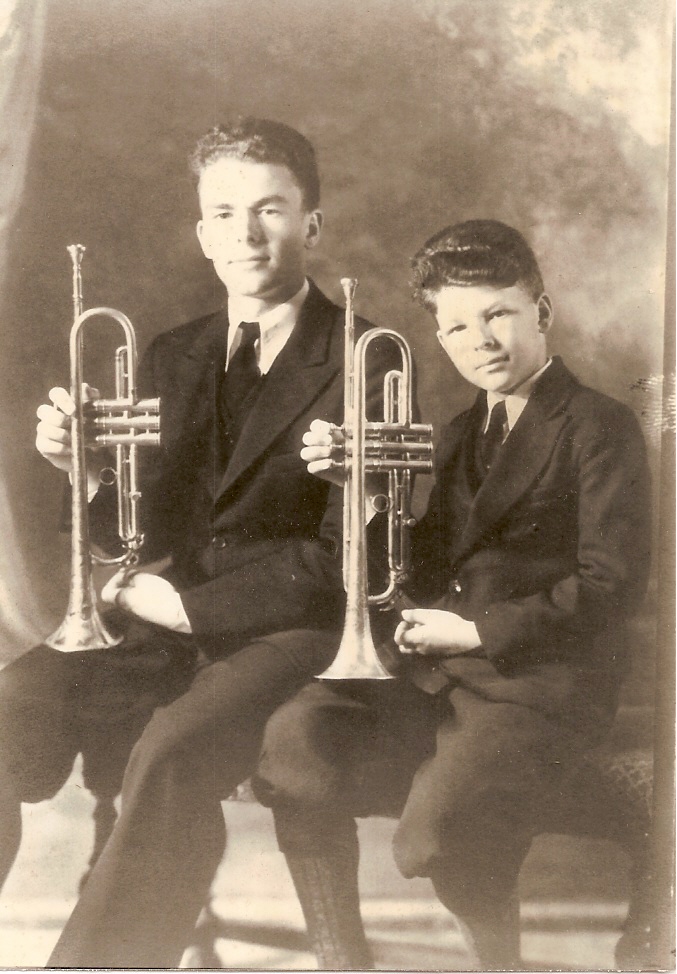
Lou Jr. and Eddie (ten-year
age difference)
(It’s easy to see, just from this
one little story, exactly how the tiny
little unmentionable subject of sex never got discussed explicitly as we
were growing up.)
[4]
Those who are familiar with things I have said over the
years about my mother’s Pund, Heppe, Myers and Kirchner
ancestors, all Philadelphia Germans, will find that Eddie’s
autobiography confirms not just many, but really, all, of
those things. I
could never remember who told me things, but I remembered
those things, partly because like Eddie, at fourteen I did a
family tree, and to do it I had to talk to everyone then
alive on both sides, Duvall and Pund. But I must admit
that just like everyone else I doubted my own memory the
older I got. Now
there’s no doubt. Obviously
young Eddie’s parents, my grandparents, Louis and Frieda,
provided him with the data for his school assignment. The first Bruce
Crawford Duvall ‘legend’ now made accurate history by this
paper of his is the line I have used over and over in
writing and in conversations with friends and family, for
years, “On my mother’s side, as far as anyone can remember,
everyone had a German last name. They were all
Philadelphia Germans, all the way up the tree, every
branch.” I
would make this claim unable to remember where I had gotten
the information and unable to prove it was true, except by
showing the enormous family tree in black lead pencil on
folded construction paper, which of course only showed all
of the German names, not the birthplaces or dates. But usually I
could not show the tree, because for many years it was lost
in an attic. And
recently, though it had been ‘found’ again, it remained
obstinately aloof and noncontributing, inside a National
Geographic Atlas of the World in a locked room in a heavily
locked house in a traditional village in the state of
Michoacán, Mexico, where I was living comfortably and
happily until a barbarian horde calling themselves the
‘Knights Templar’ drug cartel, took over the village
super-disgusting-violently between 2011 and 2013 – and that
helps explain why my uncle took me in (like a 71-year-old
homeless orphan). Other
related claims of mine over the years regarding ancestry,
likewise now shown by Uncle Eddie’s accurate autobiography
to be true, will be dealt with in subsequent footnotes. (In June of 2015 I
returned to Mexico,
stayed for a few months, got the tree, and am now helping my
daughter Anna with her 3-year-old daughter in New York City,
having brought the tree with me, in case anyone wants to see
it.)
[5]
Clearly both Eddie’s parents, Lou and Frieda, contributed
data to this school paper; but Eddie wrote it, for neither
of his parents would have committed its junior-high errors
in English usage. Uncle
Eddie recently told me the real truth, that he really did
NOT like school, despite what the paper says (for his
teacher’s eyes) in a later paragraph. For one thing he
could not see the relevance to his life of most high school
course subjects. For
another, he was constantly distracted by girls, and
especially by the fact that they seemed so little interested
in him. He
admits that he was a ‘sinful’ problem-child at this age,
given to frequent lying, and in frequent trouble with
parents; and that his much older sister, Jo (my mother, who
died in 2006), whom he has always remembered fondly and who
is still remembered by many for her kind and loving
disposition, would always find some big-sis way to bail him
out of his difficulties with their parents. (As he put it most
recently, Saturday morning, August 2, 2014, to the ten
adults in the Greek Bible class he teaches in his living
room, “I was an evil boy at 12 years old that lied all the
time.”)
[6]
The present sentence seems to be saying that some, many, or
most of young Eddie’s great-grandparents, i.e., Kirchner,
Heppe, Pund and Myers, came to the New
World about 1800. It is not clear at
first exactly who.... But,
after reading it 29 hundred times, I believe he is quoting
his parents and that they were intending to say that it was
their knowledge, or understanding, that all of their
eight grandparents (four for Frieda and four for Lou Sr.)
had arrived in America from German-speaking areas of Europe
around 1800, just 25 years after the Declaration of
Independence. Remember
that both Eddie’s parents were born about 1885-86, were
extremely sharp, and probably remembered their grandparents
like most people do, or at least recalled stories about
them, and knew perfectly well whether they had come from the
old country or not, just as most Americans today would know
if their grandparents had come from the old country or not.
“Philadelphia
by the 1770s [the decade when the American Revolution began]
had grown to at least 30,000 persons in the central city,”
says the Encyclopedia
Britannica in its article, Philadelphia: “and it was the
third most important business centre in the British Empire,
overshadowed only by Liverpool and London.”
The colony of Pennsylvania had been
founded only a hundred years before, in the 1680s, by a
wealthy and influential English Quaker, William Penn, who
laid out the streets of its first town, Philadelphia, and
welcomed to his new colony not just his fellow Quakers (who
were being persecuted in England by Anglicans and other
groups, and even were being kicked out of Puritan and
puritanical New England) but people of ALL faiths, especially
other oft-persecuted groups, including German Protestant
‘pietists’ like Mennonites (including their offshoot, the
Amish), the German ‘Moravians’ (a German Protestant
denomination), and conservative (pietist and Calvinist)
German ‘Evangelical’ Lutherans. Pennsylvania
was also one of the first colonies to welcome Jews and
Catholics. In
fact an 1899 high school class photo we have of Frieda with
her Philadelphia 11th grade girls shows a true
melting pot including Afro-Americans and girls with
Hispanic, Jewish, Irish, German, Polish and other names (on
the back of the original photo). (And on another
ancient picture of Frieda with sisters and neighbor girls
sitting on the front steps of a typical-looking Philadelphia
row house, Frieda has handwritten ‘the Jewish girl I loved’
with an arrow pointing to this Jewish girlfriend.)
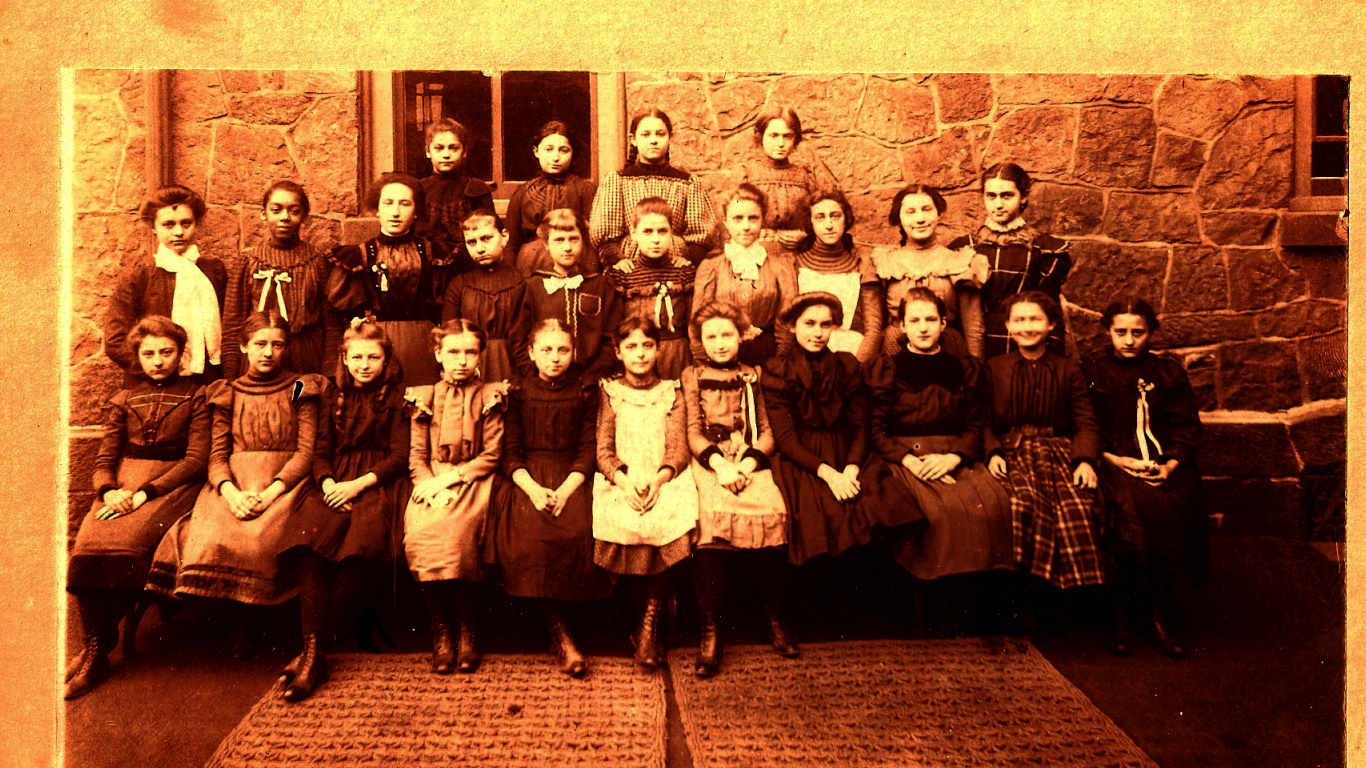
Frieda Myers’ 1899 Philadelphia
11th grade class
(front row 3rd from left)
(age 13 or 14! since she was born in 1886;
but this is explained maybe by her 1st
grade class photo
where she looks little more than 3 or 4, at
the most 5)
(i.e., she probably was precocious and
started early and/or skipped a grade or two)
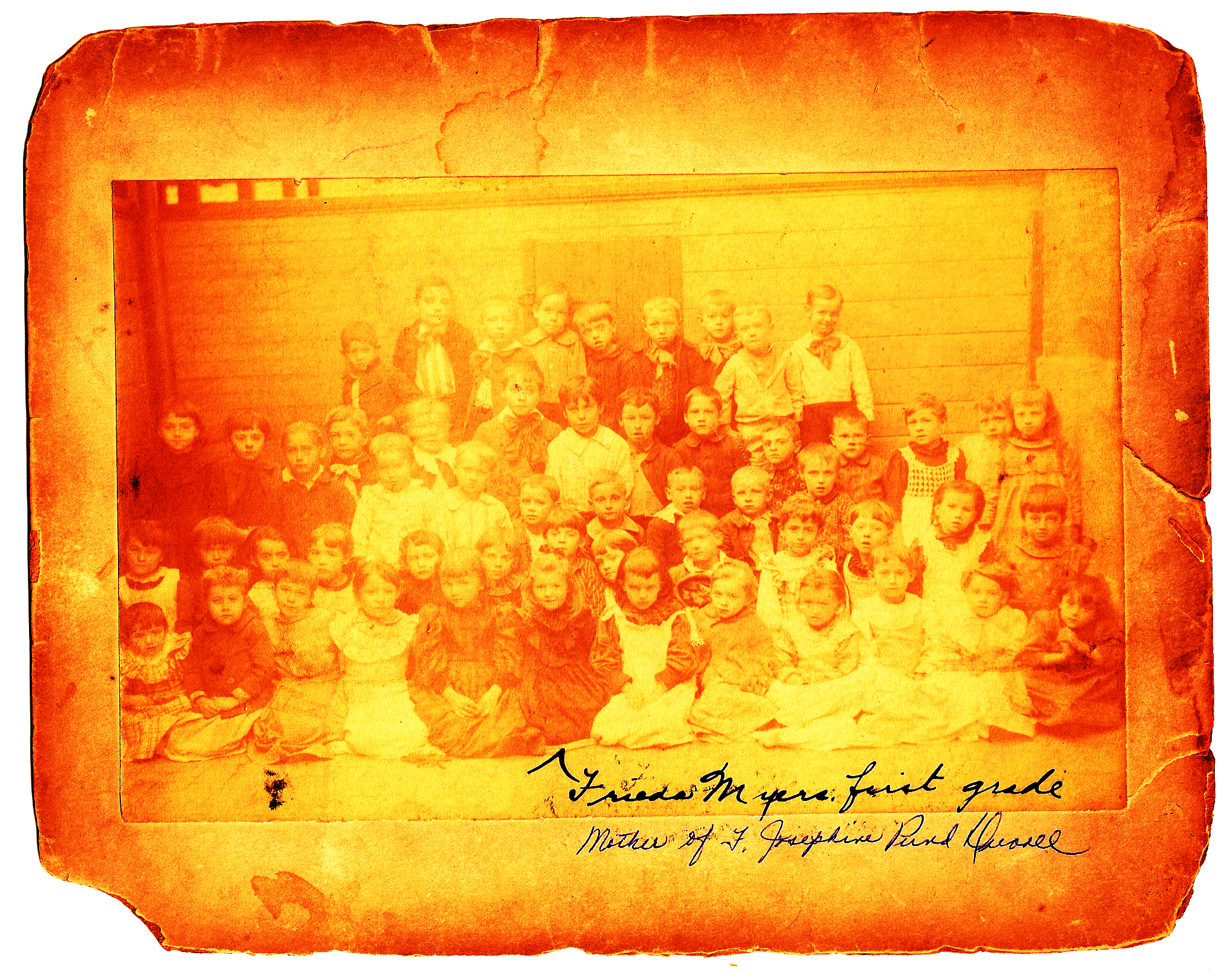
Frieda Myers’ 1889 Philadelphia 1st
grade class (a motley crew)
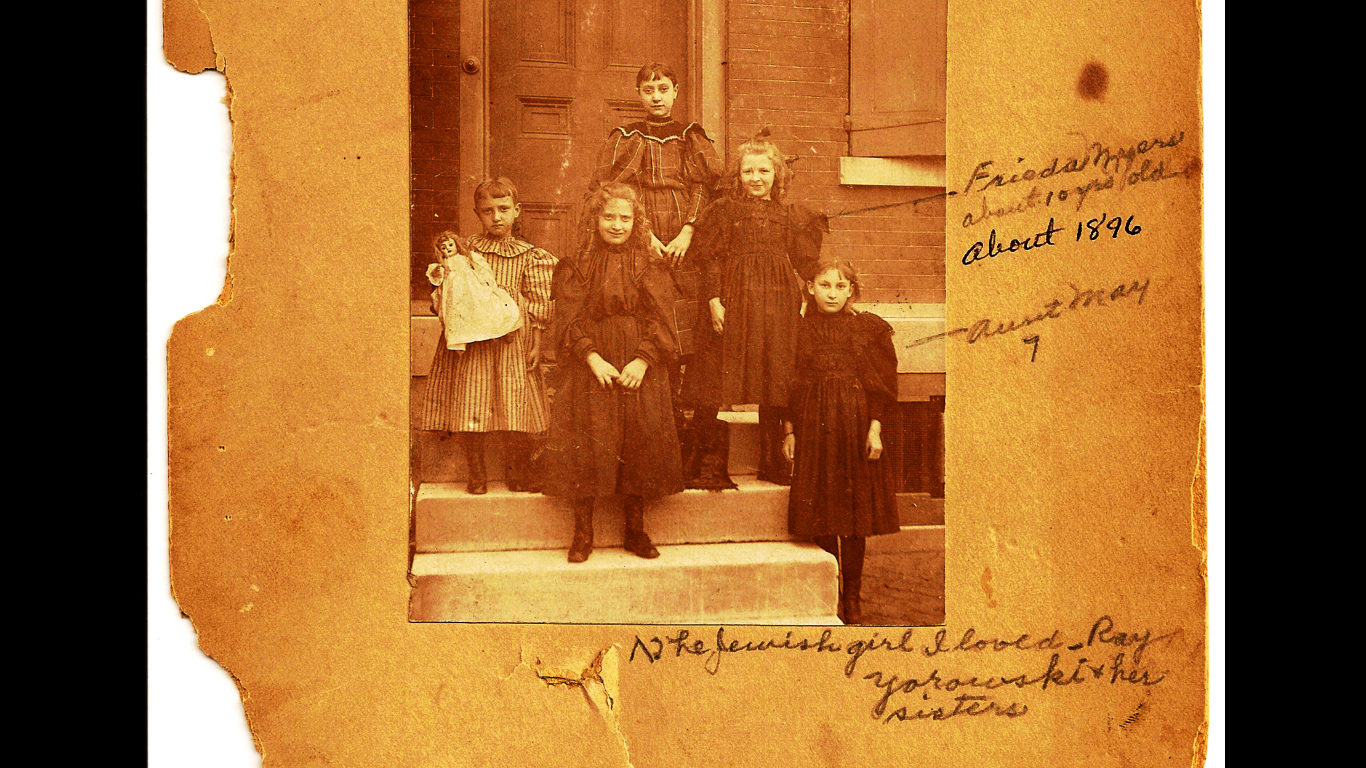
Frieda Myers age 10 with
Jewish friend (the handwriting at bottom is Frieda’s)
(‘Aunt May’ was one of Frieda’s two sisters)
The potentially tedious
(to some) discussion of Protestant sects which follows in
this issue of The Chockawhoppin
Post results from the fact that just about
everyone on my mother’s side is still today very
conservatively religious, and nearly everyone appears to
have been so for generations, a fact which implies that
many or all of Eddie’s ‘great-grandparents’ (my eight
great-great grandparents on my mother’s side) might have
come from various of these extremely conservative Protestant
denominations and may have come to Philadelphia from
continental Europe “about 1800” at least partly to
seek refuge from persecution.
“The Pennsylvania Germans, many of
whom had been persecuted in their native land,” says the Britannica in an
article entitled Pennsylvania
Germans, “...were attracted to Pennsylvania by the
liberal and tolerant principles of William Penn's
government. Their
immigration
began with the Mennonite Francis
Daniel Pastorius,
who in 1683 led a group of German Quakers
to Philadelphia, where they founded
Germantown, the pioneer German
settlement. The
early German
settlers were for the most part Mennonites,
Amish, Dunkers (German Baptists),
Schwenckfelders, and Moravians.... After 1727 the
immigrants were mostly members of the larger Lutheran and
Reformed churches [‘Reformed’ meaning not German Lutheran
but German ‘Calvinist’]....
By the time of the American Revolution [1776] they
numbered about 100,000, more than a third of Pennsylvania's
population.”
Please note the statement that:
“After 1727 the [German] immigrants [to Pennsylvania]
were mostly... Lutheran and Reformed...” (the latter meaning
strict German Calvinist).
This fact implies that John A. Kirchner and perhaps
other great-grandparents of Eddie and my mother, Josephine,
were quite likely to have been German Calvinists
(something I have been suspecting and harping on for a long
time), whether they worshipped within the Lutheran
denomination or outside it.
This conclusion is fostered as well by the
perpetually strict conservative Bible-based bent of the
family as we all have known it, generation by generation. And the inference
is suggested and supported as well by yet another piece of
data, a thick conservative and Bible-based Baptist marriage
handbook which my niece Donna DeGroodt Hickman (my sister
Evelyn’s second daughter) now possesses and pulled out to my
amazement a few years ago at her dining room table in
Northfield, N.J., when we were all sitting there after a
family reunion spaghetti and meatball dinner, the antique
book having been given her by Donna’s ‘Grandmom’, my mother
Josephine, who had received it from her mother, Frieda. The book was
originally given to Frieda’s mother (born Josephine
Kirchner) and her new husband, Harry Myers, when they were
married on “Monday the 14th day of August 1876,”
by “William Cathcart,” the minister (probably Baptist) that
married them. This
we know from the church-issued marriage certificate which
was built into the front of that marriage handbook.
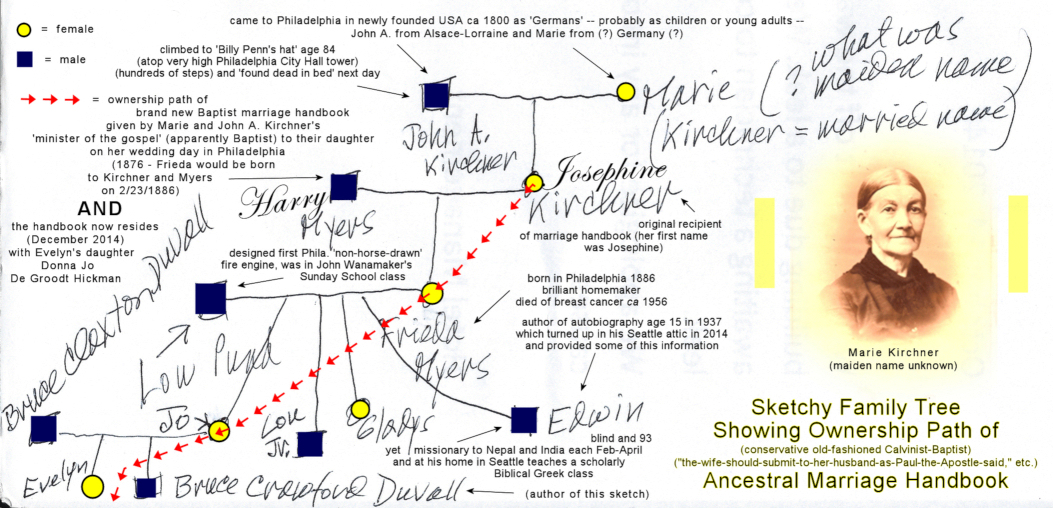
sketchy family tree showing ownership path of ancestral
marriage handbook
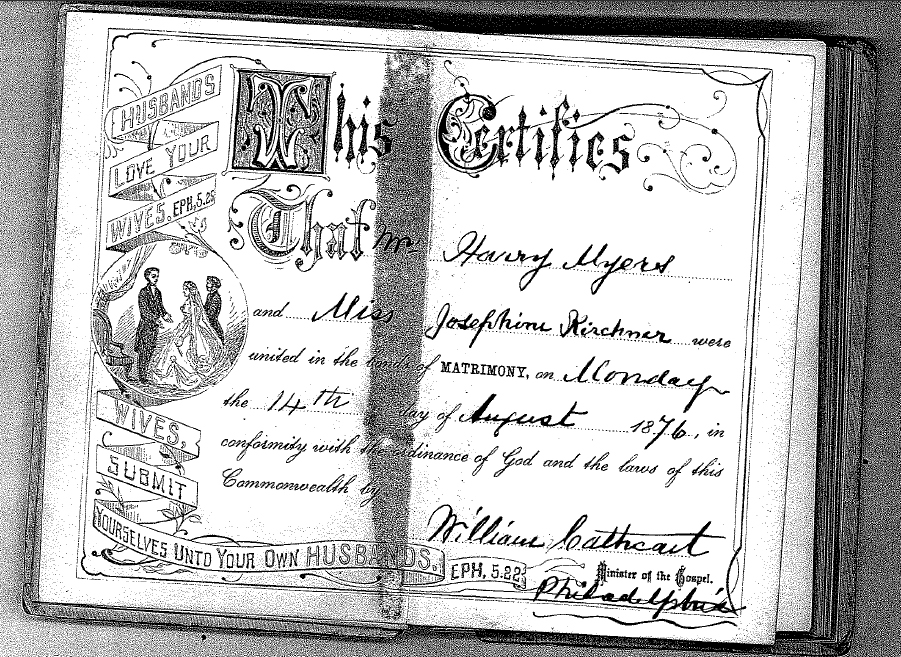
original church-issued marriage certificate
built into same Myers-Kirchner marriage handbook
(which is now a family heirloom)
note the loud quotation of Scripture, with
exact chapter and verse cited, and the word ‘gospel’
and the stress on (non-Democratic?)
old-fashioned un-women’s-libby ‘wifely submission’
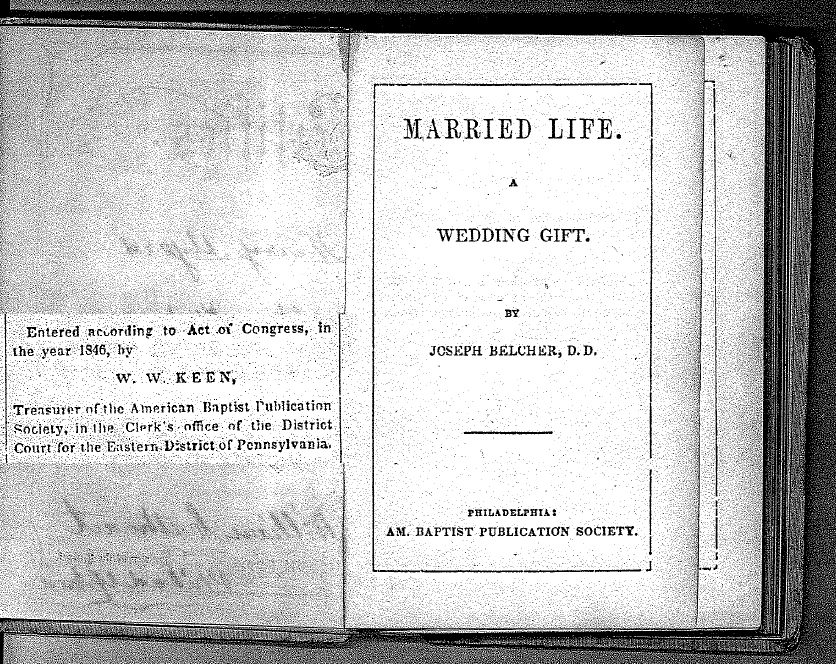
title page (and superimposed publication
page) of the same marriage handbook (published 1846)
Jews, Catholics and
others may feel ramrodded or gumswuckled by the present
hootenanny on a hickey about Protestant sects; but just be
super-patient please and try to understand that for years I
have been trying to comprehend the USA’s (or at least a
major and clamorous part of the USA population’s) undying
and often unconscious devotion to strict old-fashioned
conservative Protestant Christian principles. I have been trying
diligently to see how my own family has fit into the
hyperpolarized political dynamic now current: they are, in
fact, almost always on the side of the extreme religious
(‘Evangelical’) right.
And please try to understand that despite some minor
differences, many conservative American Baptists, Methodists
and Presbyterians (denominations originating mostly from
England, Scotland and Ireland) as well as many very
conservative Protestants from Switzerland and southwest (and
Rhineland) Germany always were and still are today ALL
pretty CALVINIST IN THEOLOGY, and in their ideas of church
government, i.e., essentially the same in
their deepest understanding of scripture, doctrine, faith
and practice. (And
Calvin, by the way, for you Roman Catholic theology nerds,
just so you can relate to him maybe a little bit as a human
being like you and me (in some ways), was born and raised in
the Roman church in France, was declared a Roman cleric
there as a 12-year-old child, was tonsured (given the
monkish haircut) at 12, and eventually was theologically in
most ways essentially Platonistic-Plotinian Augustinian,
i.e., influenced by late-Roman-empire Roman Catholic St. Augustine,
not by medieval Aristotelian
super-Roman-Catholic St.
Thomas Aquinus.
And Calvin’s goal from day one was not to break
up the church, but just to get some basic PIETY back into
the crazily impious late-medieval and early-Renaissance
Roman church he had grown up in. Everybody should
be able to relate to that, especially if you know the crazy
cockamamie impious things the Roman church was responsible
for in those days.) (If
you don’t know about those things, read the opening chapter
of Will Durant’s The
Story of Civilization Vol. 6: The Reformation [New
York: Simon and Schuster, 1957], which explains in gory
detail why so many good Roman Catholics starting in the
1300s were so thoroughly disgusted with their own Roman
church.)
The ‘American Baptist’ marriage
handbook was then passed on (mother-to-daughter) to my
grandmother, Frieda Josephine Myers, by her mother (who I’m
sure you remember! had been born a Kirchner) perhaps on the
day of Frieda’s marriage, somewhere around 1908, when she
married Louis Luer Pund Sr., my grandfather; or maybe she
inherited it later. Still
later my mother received it, and much later my
mother gave it to her granddaughter Donna due to Donna’s
telling her Grandmom about her ‘love of old books’, as Donna
recently explained to me.
This all suggests
that probably
Mr. ‘John A. Kirchner’, Uncle Eddie’s and my mother’s
‘great-grandfather’ (their mother Frieda’s mother’s father),
who came over ‘about 1800’, 25 years after the American
Revolution (and died the day after climbing to Billy Penn’s
hat), came as a conservative German Calvinist
and then quickly moved ‘up’ (or ‘over’) socially to a
conservative English-speaking
quasi-Calvinist church, the Baptist. “Most scholars
agree...,” says the digital Encyclopedia Britannica
in its article, ‘Baptist’,
“...that Baptists, as an English-speaking denomination,
originated within 17th-century Puritanism as an offshoot of
Congregationalism.” (The
‘Puritans’ and ‘Congregationalists’ were strict Calvinists. This puts the
Baptists right in the Calvinist tradition from the start,
though some Baptists today would quibble with Calvin and/or
Calvinism over certain things, mainly ‘baptism’.)
Here’s how that (not-so-tortured)
reasoning would go, that John A. Kirchner was of a
particularly conservative German Protestant background,
i.e., essentially Calvinist:
If you consider that John A.
Kirchner ‘spoke seven languages fluently’ (as stated later
in the ‘autobiography’) and came to Philly as ‘a German’,
‘from Alsace Lorraine’ (as also stated later), and that his
daughter was soon the one to whom her Baptist or
Baptist-sympathetic minister gave the Baptist handbook
(published by the American Baptist Publication Society in
1846) on her wedding day (as the handbook plainly states on
its title page: “MARRIED LIFE.
A WEDDING GIFT.
by Joseph Belcher, D.D.”), then it is not at all
far-fetched to surmise that John A. Kirchner, father of this
bride, came to America as a German Calvinist or
quasi-Calvinist, but changed denominations in Philly, as a
young adult (changed from German Calvinist to some variety
of American Calvinist, most likely Baptist). In fact, the
conclusion is virtually compelled. (The bride
probably would have been married not in her husband’s
church, if his were different, but in her own parents’
church, which was apparently Baptist or
Baptist-sympathetic.)
Perhaps European culture nerds will
want to argue that Alsace Lorraine, a tiny part of Europe,
is part of France, not Germany, and that most people there
must speak French, therefore, not German; and that the
French for centuries were almost 100% Catholic. But in fact, Alsace has been fought over by France and Germany
for centuries and has a split personality. At times,
therefore, it has been part of Catholic France, and at other
times it has been part of half-Protestant Germany
or has remained semi-independent. (And the
encyclopedia says that even today 75% of Alsatians speak a
kind of German dialect called ‘Alsatian’.)
“Protestantism
made important gains in Alsace during the
Reformation,” says Britannica
(in its article, Alsace),
“and Strasbourg,
where the [‘protestant’] reformer Martin Bucer
was especially prominent, became the centre of
Alsatian Protestantism.
That city's Protestant influence was countered,
however, by the resolute Roman Catholicism of the Habsburgs
[the royal rulers], who tried to eradicate heresy in upper Alsace.”
Here we see the beginning of the
persecution of the ‘heretic’(!)
Protestants – around the mid-1500s – and the encyclopedia
goes on to explain that French (Catholic) influence over Alsace
grew and grew, up until the French Revolution (1789), when
zealot French revolutionary rationalists robbed or destroyed
many French churches, Catholic or whatever; none of which
could have been much fun for a conservative Evangelical
Protestant. We
know in fact that throughout those centuries (1550-1800)
French Protestants, called Huguenots (most of them strict
Calvinists) were literally massacred or intimidated into
exile by French Catholics, in an effort to keep France as
close to 100% Roman Catholic as possible. By 1800 some
of the Kirchners in Alsace (and maybe other of Eddie’s
‘great-grandparents’) most likely were fed up with this
miasma and chose to come to William Penn’s ‘City of
Brotherly Love’, Philadelphia, where religious toleration
was practiced quite successfully. And furthermore,
and to be fair: many ardently conservative Protestants, and
especially diehard Calvinists (and quasi-Calvinists) tend to
NEED an extra degree of ‘toleration’, because historically
they tend to be a little obstinate, or maybe even
in-your-face, about their faith and therefore tend to provoke persecution
of themselves at times, unfortunately.
Strasbourg’s original Roman Catholic
church ‘reformer’ or ‘protestant’ clergyman, Bucer, by the
way, for you Calvin history buffs (especially me), became a
model and older mentor to the young Calvin during the years
when he fled and sought refuge in Strasbourg, Alsace, from
the persecution of reform-minded ‘protestants’ that was
happening at the Sorbonne in Paris (the University of
Paris): where Calvin had studied (age 12-20 roughly) and
helped author an inflammatory Protestant/Lutheran paper that
was then mass-produced and posted by someone on walls all
over Paris, throwing his safety into jeopardy. Once self-exiled
for safety’s sake in Alsace, Calvin learned from Bucer in
Strasbourg how to mediate and wend a calmer middle path
among Protestant and Catholic emotional extremes of the
kinds shown at times by both the protesting ‘protestants’
(like Luther and Zwingli), and the Roman church; and too,
from Bucer in Strasbourg, Calvin learned how to put (and
hold) together in a country not his own (not France) a
congregation of French Protestant (‘Huguenot’) self-exiles
mixed with Alsatian locals, a knowledge he used to
magnificent effect a few years later, when he pasted
together the Protestant theocratic city-state of Geneva in
the early to mid-1500s in the French-speaking part of
Switzerland, a country likewise not his own, from a mix of
local (Swiss-French-speaking) Protestants and a throng of
persecuted refugees who had fled his country of France. From Bucer’s time
(ca 1520-1530) on, Strasbourg and the rest of Alsace were a
center of ‘German’ Calvinism (many Alsatians, as mentioned,
still speak a kind of German today, even though Alsace has
been part of France for a long time). French culture
dominates Alsace today in many ways, since it has been part
of France for so long; yet, when my sister and I toured
Europe in 1998 looking for our ancestral roots, we stayed in
a medieval wine town in Alsace, in a hotel where a lively
group from Germany
had rented most of the rooms and were spending the evening
in the French-Alsatian hotel’s restaurant, singing rousing German drinking
songs to an accordion in strident pure High German as a kind of
futile but sincerely offended protest against the Francification of
Alsace, still sadly a part of France, which they
considered, Hitler- and Nazi-style, to be STILL REALLY
GERMAN NOT FRENCH IN ALL TRUE REALITY, if you know what I
mean.
(No wonder John A. Kirchner ‘spoke
seven languages fluently’!
French, German, Alsatian and English would have been
certain starters.)
But despite Calvin’s oft-seen
political finesse and his knack at getting along moderately
in many things, his ‘Calvinist’ spiritual descendents of all
denominations and countries through subsequent centuries
have tended to be ardently strict, meaning anything but
lukewarm in their religious politics and political
religiosity; until the 20th century, of course,
when many of them ‘fell’ smack dab and loudly into ‘liberal’
and ‘modernist’ thinking, including most of the Baptists and
Methodists and Presbyterians in America – but – ahem – not the
Methodists, Baptists or Presbyterians in our family.
I’m trying to say that: John A. had
to be pretty evangelical to marry off his daughter in a
church which shouted
scripture verses even on its marriage certificates, a church
which found it essential to clarify on a
very formal certificate that the man doing the marrying was
not just any
common church ‘minister’ signing a formal marriage
certificate, but a ‘minister OF THE
GOSPEL’, meaning the GOOD NEWS of Jesus’
salvation for sinners; just in case that, by so shouting,
some careless reader of the certificate a hundred years
thence might yet be evangelized, i.e., reminded of why he or
she was created, and then, once reminded, might be brought
to salvation. Most church
marriage certificates of that day probably would have just
said, “Minister sign HERE.”
But not the marriage certificate in John A.’s church,
you see.
[7]
Josephine lived to 96, Lou Jr. to 95, Gladys to 84, just to
name three longevous ones I’ve known; and Eddie, their kid
brother, is by now 93, and still as rambunctious as a
twelve-year-old.
[8]
I should have asked Uncle if he remembered what the word
‘confection’ had meant to him back in 1937 when he wrote
this autobiography. ‘Confection’,
a word little used in the USA any more in 2015, used to
mean, according to the unabridged dictionary, ‘mixture,
delicacy (a mix of fruits, nuts and sweets), sweetmeat,
preserve, or candy’, and sometimes it even meant
pharmaceutical mixtures.
A store which sold such mixes made by confectioners
was called a ‘confectionery’, and often sold also ice cream,
cakes, pastries and candied fruits. All of which might
help explain Eddie’s and my mother’s love of sweets, and her
habit of baking sweet, lightly anise flavored,
molded-and-design-engraved German Springerle cookies
every Christmas (which she pronounced with a kind of German
accent as ‘shpringerly’).
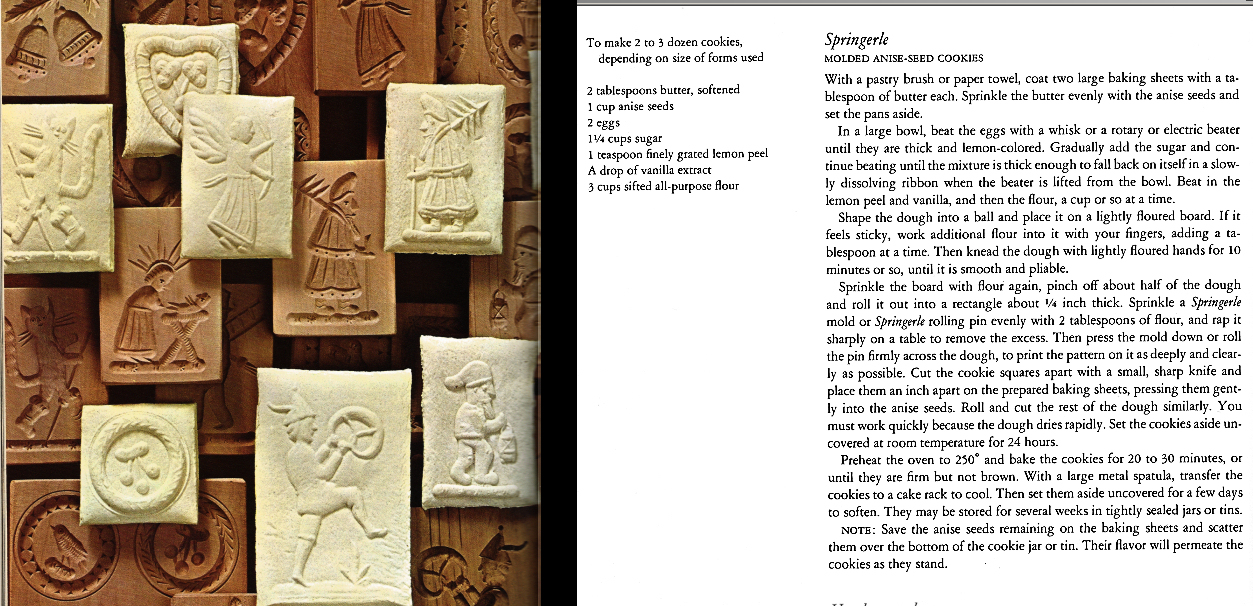
the white ones are end-product Springerle
cookies, the darker things are the woodcut cookie design
molds
(Germans are known for woodcut arts and
handicrafts)
(Springerle cookies are from Swabia, i.e.: to
get to nearby Swabia from Alsace
you walk a few miles, cross the Rhine and
walk to the other side of the Black
Forest and you’re there)
(all above info from Time-Life German recipe
book given me by Jeanne Niederlitz in Mexico,
thanks Jeanne)
An article in Microsoft’s
Encarta
encyclopedia throws more light on my grandfather-Pund’s two
families of origin, the Punds, who were ‘confectioners’, and
the Heppes, who were ‘all’ musicians, musical instrument
manufacturers, and also confectioners. Encarta’s article
on “New Jersey” happens to
mention a middle class of German immigrants during the 1840s
and 1850s: “The middle classes [of New Jersey] were
largely made up of storekeepers, clerks, and skilled
artisans. Many
of the latter [the ‘artisans’] were German immigrants, who
earned decent wages as piano and instrument makers,
furniture carvers, brewers, and confectioners.” I think we can
assume the same demographic applied to Philadelphia,
right next door to New Jersey. If so, we can
assume that the Punds and Heppes were mostly middle-class,
unless occasionally someone became unusually wealthy, and
that the Myers and Kirchners, on the other hand, were from a
higher social bracket, ‘upper class’ and ‘nobility’, as
Eddie’s autobiography states right at this point. I’d also like to
add that if the German-immigrant ‘artisans’ of New Jersey
and Pennsylvania ‘earned decent wages as piano and
instrument makers, furniture carvers, brewers, and
confectioners,” as Encarta
states, then my grandfather came from people knowledgeable
in three out of four of those categories. His parents’
families made musical instruments and confections, and he
himself hand-crafted furniture, I can attest, because I own
a very fine hand-carved walnut desk, an elegant walnut trash
basket, and a stately clothes tree, also probably walnut,
all of which he carved and put together by hand. He populated the
secretary-style desk with little wooden drawers made of the
wooden boxes which had housed the Cuban cigars he smoked all
the time. The
fact that no one in his family was a ‘brewer’, the fourth
category of common German-immigrant middle-class artisan,
adds weight to my claim that my mother’s people were mostly
very conservative Protestants.
Like my grandparents, their parents and grandparents
very likely did not approve of drinking, for drinking has
always been a strict-Calvinist no-no; since it, like many
other vices, creates a faux or
unreal, unnatural personality, when the only real
relationship possible or desirable between man and God, in a
Calvinist world, is a sincere
and real
and natural
one.
.
[9]
Heppe Piano Company in Philadelphia, defunct
long since.
[10]
‘Myers’ = ‘Meyers’. The
German word ‘Meyer’
means ‘overseer of the estate’. ‘Kirchner’ could
have meant ‘one who raises cherries’, or perhaps ‘cherry
wine vintner’ (Kirsch
= cherry). But
a more likely meaning would be churchman (Kirche = church),
church builder, or church keeper. It’s interesting
that both names, Myers and Kirchner, imply something to do
with stewardship, i.e., taking good care of what the Lord
gave you to take care of.
[11]
Atop the very high tower of Philadelphia’s City Hall stands
an enormous statue of the city and state’s founder, William
Penn, and he is wearing a late-17th-century
Quaker hat and suit. And
it used to be – and still may be – possible to climb steps
to the brim of that hat, just as you can climb to the Statue
of Liberty’s crown.
[12]
John A Kirchner, who climbed to Billy Penn’s hat the day
before he died, would have died around the end of the
American Civil War, apparently, assuming he emigrated at
about age 20 around the year 1800, and knowing as we do that
he died at age 84. (However,
if he came over ‘around 1800’ as a little boy, he
would have died in the 1870s or 1880s.) In any case,
fanatical self-sacrificing overachiever drive like his
(which probably finished him off when he climbed to Billy
Penn’s Hat ‘counting the steps’) still propels the family. ‘Easy does it’
does not. Max
Weber, the German sociologist who wrote the classic The Protestant Ethic
and the Spirit of Capitalism would have called it
‘Calvinist work-ethic asceticism’. (In fact, Weber
knew what he was talking about in that famous scientific
paper because his parents resembled mine, in that his father
was a more relaxed fun-loving Protestant, a Lutheran from
near Berlin, whereas his mother was a strict pietistic
German Calvinist from the Rhine valley, like John A.
Kirchner’s people [as I propose], and like my mother and her
parents and sibs [as I know from experience!].)
[13] Uncle Eddie tells
me that his father (my grandfather, Louis Luer Pund, Sr.)
went to college at, and graduated from, the University
of Pennsylvania. Either during
those years or after them, or both, says Eddie, his father
taught at the high school from which he had graduated,
Philly’s Central High, and after that, at South Philly High,
in what was Philadelphia’s
Italian
neighborhood in those days (and still is today, I believe,
judging from Rocky Balboa movies). At South Philly he
taught mechanical drawing.
[14]
This is consistent with the ‘myth’ that we have all carried
with us for years that Eddie’s ‘Daddy’ (my grandfather,
Louis Luer Pund) designed ‘the first non-horse-drawn fire
engine in Philadelphia’, the exact verbal designation of his
achievement which stayed in my memory all my life but which
none of us could verify, once almost everybody was gone and
we suddenly found ourselves ever more interested in these
subjects, to our frustration.
With this sentence the ‘myth’ has become reality, for
it came straight to 14-year-old Eddie from his father,
‘Daddy’ himself, or maybe from his mother, who never would
have distorted a dot on a jot of Biblical or any other kind
of Truth. I
used to think this meant he had designed a steam-driven
fire engine, but Eddie has clarified that it was an internal
combustion engine. In
fact, Eddie and Marilyn, when they were in Philadelphia
a few years back, tried to track down the company in which
Louis Luer Pund designed that engine.
Psychological detectives among you
may protest, “Hey, dood, you just said Eddie had a penchant
for lying, back then.”
True, Sherlock, but::: I see no evidence that he has
done any stretching in this school paper, except when he
starts talking about his wonderful attitude toward school.
[15] John Wanamaker
(1838-1922) was a shining light of Philadelphia culture in
the late 19th and early 20th
centuries. He
eventually became Postmaster General of the USA
(and thus a member of U.S. President Benjamin Harrison’s
cabinet); but originally he rose to fame as a department
store magnate in Philly.
He bought an old multi-story entertainment palace
which had a massive pipe organ and turned the place into THE
department store in Philadelphia, THE
classy place to buy anything.
I bought my shiny black upright Yamaha piano there on
the 8th floor around 1968 and became friends with
the kid who sold it to me who was a piano major at Curtis
Music School and who
gave periodic concerts during store hours on the Wanamaker
organ. The fact
that Wanamaker’s Dept. Store was far more than a department
store, is the thing to understand about the store and about
the man as well. The
businessman John Wanamaker (1838-1922) was clever in a way
that had even spiritual, cultural and family impact in my
life and many other people’s lives. Wanamaker’s Dept.
Store was right next to the same ‘Billy Penn’, i.e. the Philadelphia
City Hall
(with the very big statue of William Penn atop its very high
tower), mentioned in young Eddie’s previous sentence; but it
was far more than a huge city store. Philadelphians
went there for two other big reasons:
to listen to dynamite booming pipe organ concerts several
times a day; and to meet a cherished someone at the big
bronze ‘Eagle’ sculpture in the middle of the first floor by
the Market
Street entrance. “Meet me at the
Eagle,” people would say, not even having to mention where
the eagle WAS, because everyone in the Delaware Valley knew. But you could
combine all of these experiences and more. You could meet
someone you cherished, say a family member or a girlfriend,
at the eagle, and stay to hear a concert as you stood there
among the lingerie, looking at the two- or three-story-high
pipes, wondering if they’d rattle themselves off the
music-making wall; and then you could go together up to the
6th or 7th floor and dine in the
snazzy Wanamaker’s cafeteria.
A first class date (in those days).
[16]
Here I suspect Uncle Eddie was advised by his mother NOT to
mention HOW his ‘Daddy’ knew John Wanamaker ‘intimately’. Someone in the
family once told me that Eddie’s ‘Daddy’, my grandfather,
‘was in John Wanamaker’s Sunday School Class’. (The fact that
discovering this paper has confirmed so many other detailed
memories of mine, suggests that this very detailed memory of
mine is probably accurate as well.) Once you hear the
words ‘Sunday School’, Eddie’s choice of the word
‘intimately’ seems to make a lot more sense. In a youth or
young adult Sunday School class you would talk aloud with
many others listening, about the most important and intimate
thing, your walk with God.
But what does ‘John Wanamaker’s Sunday School class’
mean exactly? It
might mean that they were both adult men in an adult class
with someone else as teacher; but since ‘Daddy’ (my
grandfather), born ca 1885, was a youth or young man at this
point, ca 1900-1910 (trucks with combustion engines had just
been created in 1896 in Germany), age 15 or 25 roughly, and
Wanamaker was 60 or 70, it’s much more likely that it was as
I have always understood and imagined, that ‘Daddy’ was in
the Sunday School Class which John Wanamaker taught: for that’s
what the phrase ‘so-and-so’s Sunday School class’ would usually
mean, more than anything else.
But, you say, so perceptively: What
American business magnate would be caught dead teaching
Sunday School??!! (Would
Donald Trump teach Sunday School?) Yet, in 1900-1910
it would have been far more likely than today; and besides,
Microsoft’s Encarta
encyclopedia article, “John Wanamaker,” says that from 1870
to 1883 Wanamaker was ‘president of the Philadelphia YMCA’,
the ‘Young Men’s Christian Association’, a youth-focused
church organization which in those days was much more
religious and church-based than it is today. An Encarta article,
‘Young Men’s Christian Association’ explains that from the
date of its founding in 1844 until the 1960s the YMCA
“...attempted to combat idleness among young workers by
means of Bible studies and prayer meetings,” in addition to
physical activities like overnight camping (which the YMCA
made popular) and all kinds of gymnasium exercise. Volleyball and
basketball were both invented in YMCA gyms, says Encarta.
My only question is ‘John
Wanamaker’s Sunday School class’ in which church? We don’t know, but
some genealogic zealot could dig up a biography of Wanamaker
and find out, and some day I just may do that. (Or, could he have
taught Sunday School at the Y?)
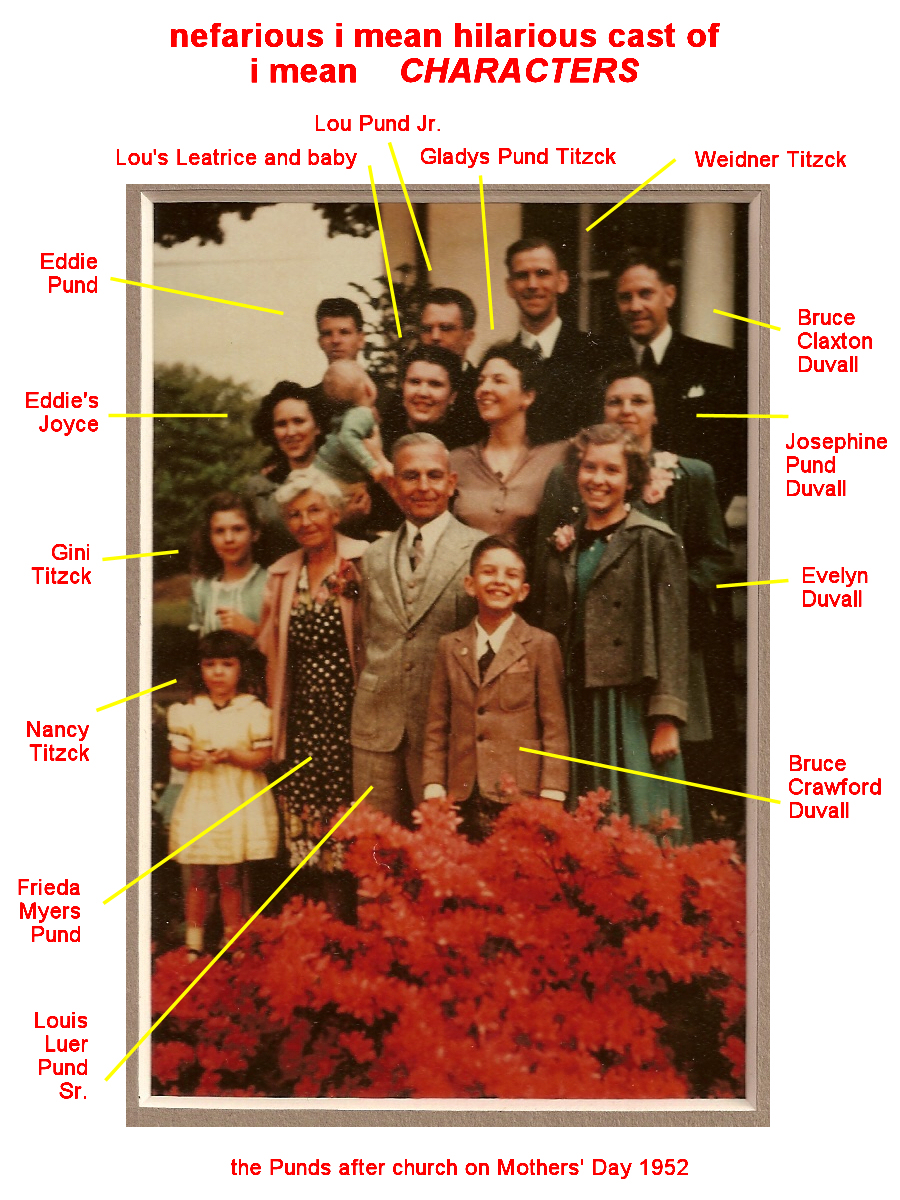
(behind Gladys' famous azaleas:)
Lou and Frieda & all 4 offspring with mates & kids
nobody missing or killed in a
head-on with a drunk driver*
a classic 1950s photo
(*Weidner and Lou Sr. lost their
lives together thusly in 1955 on the Ben Franklin Bridge)
[17] See The Chockawhoppin
Post, Vol. 2010 No. 4, December 6, 2010,
section 8, entitled “Remembering Mom and Dad (to see if any of this
was their fault),” for a detailed telling of how the
Punds, meaning my mother and her 3 sibs, Eddie, Gladys,
Lou Jr., and their parents, Lou Sr. (‘Daddy’ in the
autobiography above) and Frieda, toured the USA several
various summers in a boxy 1920s sedan with big running
boards. (Anyone
who cannot find this Post in their
digital storage bin is welcome to request it and the Post will send it
Post-haste.) At Uncle Eddie’s
home in Seattle, where I visited May 1 to September 1,
2014, he told me that they would drive the sedan out the
Lincoln Highway, US 30, to Chicago, beyond which there
were ‘no paved roads’, not even US 30, meaning that the
so-called Lincoln ‘Highway’ (US 30) and all other roads
and ‘highways’ beyond Chicago were nothing but mud when it
rained. They
would tour the west on dirt and mud ‘highways’ even to the
Canadian Rockies, drive dirt and mud ‘highways’ all the
way to the Pacific, go south on dirt and mud highways
through California to the Grand Canyon, Zion and Bryce,
and then head back to Chicago getting their last
end-of-summer kicks
on the famous old dirt-and-mud Route (US) 66, much
of which has since been buried or sidelined by an
interstate. It’s
no wonder that everyone descended from Lou and Frieda in my
generation (except my sister, Evelyn) ended up living in
the West. The
following paragraph will help to explain this further.
Basically everyone just mentioned
has told me stories about these massive summer-long family
camping adventure trips ‘out west’ during the 1920s and
’30s, which were even ‘pioneering’ in their own way. Eddie is the most
recent to tell those stories, and before that my mother was
the usual one; or occasionally Uncle Lou; but I also
remember that when my kids, Lenno and Anna, were about 8 and
7, or 10 and 9, on one annual August trip from Denver to New
Jersey we three hooked up with Aunt Gladys and took her out
to eat at an Italian Diner in Gloucester, near Collingswood;
and in that leatherette booth, with her shiny white hair she
told the three of us many loud and laughing energetic tales
I had heard before from others, but which may have been new
to the kids, about how the Pund family had gotten stuck in
‘gumbo mud’ whenever it rained and had been forced to dig
the car out of the mud (unless they wanted to stay in the
mud forever like dinosaurs) (and Eddie recently added that a
farmer would come by and pull them out with a tractor and/or
a team of horses); and had hiked up a part of
glacier-covered Mt. Rainier in Washington state and then
slid back down the ice and snow on their butts, dressed in
‘tin pants’ (pants with metal seats) rented from the
National Park; or had camped in tents and cooked in
Yellowstone, where they had to raise all food into the air,
hanging it from branches; and when bears came (for in
Yellowstone bears always have come, even to
this day), had banged with tin ladles on tin pans to scare
the bears away; and how they had packed a whole household of
personal items into the attic for the summer and rented out
their furnished home to Philadelphians who wanted to get
away to the ‘Garden State’ from the sticky city summer heat
of Philly; since ‘Mother’, Frieda, worked only at home, as a
‘housewife’ and homemaker, and ‘Daddy’ was a school teacher
and had the whole summer free.
(My mother always spoke of [and to]
her parents very
respectfully as ‘Mother and Daddy’, and her kid brother
Eddie still does the same.)
And how ‘Daddy’, a mechanical
engineer, knew how to repair cars. So that I always
understood this to mean that he (my grandfather) repaired
the two-seat (front seat and back) boxy sedan whenever it
broke down on those legendary pioneering trips; but Eddie
just recently corrected me emphatically saying ‘THE CAR NEVER BROKE
DOWN’ because ‘Daddy’ had ‘put it together so well to start
with’. (“He
used to take apart anything,
including whole cars, lay the parts carefully on a sheet,
clean and repair and lubricate any parts in need, and put
back everything where it belonged, running better than
ever.”) (And
Eddie himself still does such things, even blind.) And everyone has
always told the story that luggage was stored outside the
car on the big running boards, while the bedding, during the
daytime, was layered on the back seat to raise all four
children up for easier seeing out the windows. But Eddie has
corrected this too. He
‘NEVER SAT’. He
only STOOD UP on the floor in the back, especially on the
1927 trip when he was only 5, my mother was 17, and Lou Jr.
and Gladys were 15 and 11.
Then there was the story of meeting
other cars from New
Jersey. Since historically
it was just the very beginning of this very adventurous kind
of Teddy Roosevelt family western auto travel, if you ever
did meet another 1920s or 30s car with a New Jersey license
plate ‘out west’, it was a rare and special thing, and so
you stopped driving and everyone jumped out and embraced the
people of the other car and shared survival tales and info. (As I’ve been
known to do in a remote part of Mexico upon
meeting another gringo, even as recently as 2011.)
And to this has just been added
Eddie’s story that his father, my ‘Bampa’ (I was unable to
say ‘Grandpa’ when I first learned to talk) would grab a
handle and turn it to get the car engine going! There was no
‘ignition’ inside the car, and no key. Everything was
still mechanical.
And, finally, “How did all of this
get started?” I asked Uncle one day in Seattle. “My mother
[Frieda] read National
Geographic,” he said, “and one day she said to Daddy,
showing him pictures and maps, ‘Lou, why can’t we do this,
why can’t we travel out west?
If you’re teaching school, we have the whole summer
free’, and she began to think about how it might be done. And that’s how
they came up with the idea of renting out their house for
the summer, to help pay for the trip.” Since they camped
in tents and prepared their own food, and would have had to
buy groceries and clothes anyway if they’d stayed at home,
their only real potential trip costs would have been
gasoline, oil and automobile wear and tear. Not even the
public campgrounds cost money in those days. National Parks and
their campgrounds were free to everyone in the beginning, a
fact that still aggravates Uncle and requires – given his
age, sacred early memories, and conservative
politico-religious bent – that he protest any
such public park charge, during these modern days of what he
calls ‘government evil and corruption’, by boycotting
any public facility that demands an entrance fee from the
very public whom it is supposed to be serving, a public who
already has paid hefty taxes to create and maintain it. (He compromises
with ‘corruption and evil’ in certain instances, however,
for example by purchasing a permanent lifetime pass to all
National Parks, a handy and inexpensive way to avoid all of
the Satan-begotten individual park fees.)
[18] M.B.R. = initials
of the teacher at Collingswood
(New.Jersey) Junior High who graded the paper in 1937.
Bibliography/sources were two
digital encyclopedias for personal computer; and the King
James Bible:
Encyclopedia Britannica
2008 Ultimate Reference Suite articles: “Philadelphia,” “Pennsylvania
Germans,” “Alsace,” “Lorraine,”
“Alsace-Lorraine,”
“Max Weber (1864-1920),” and “Baptist.”
Microsoft Encarta
Premium 2006 articles: “John Wanamaker,” “Young Men’s
Christian Association,” and “New Jersey.”
Bible verses at end of newsletter:
(as plea) Exodus 33:13 and (as thanks) Psalm 36:7-9.
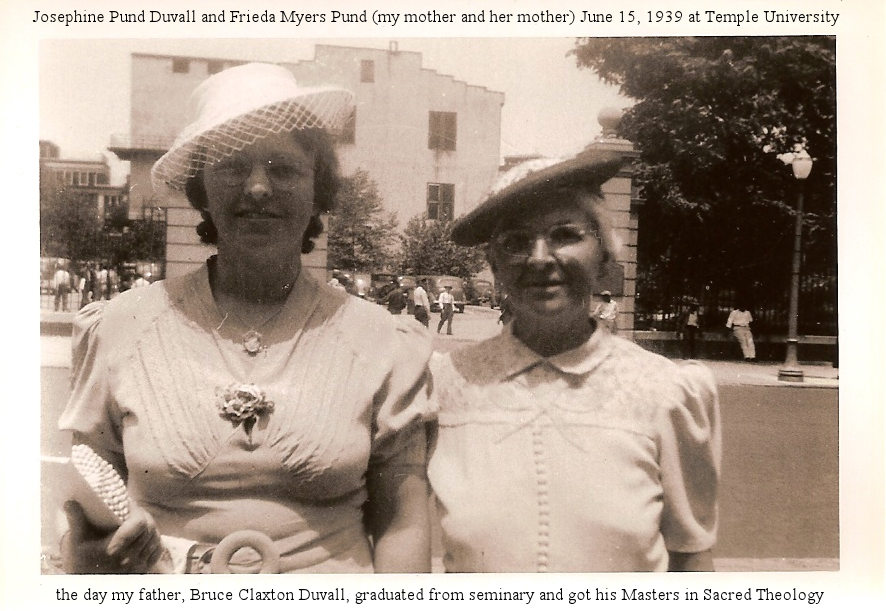
high 1939 Philly fashion for
elegant church ladies (Frieda and Jo)
attending a spiffy higher-degree Sacred
Theology graduation
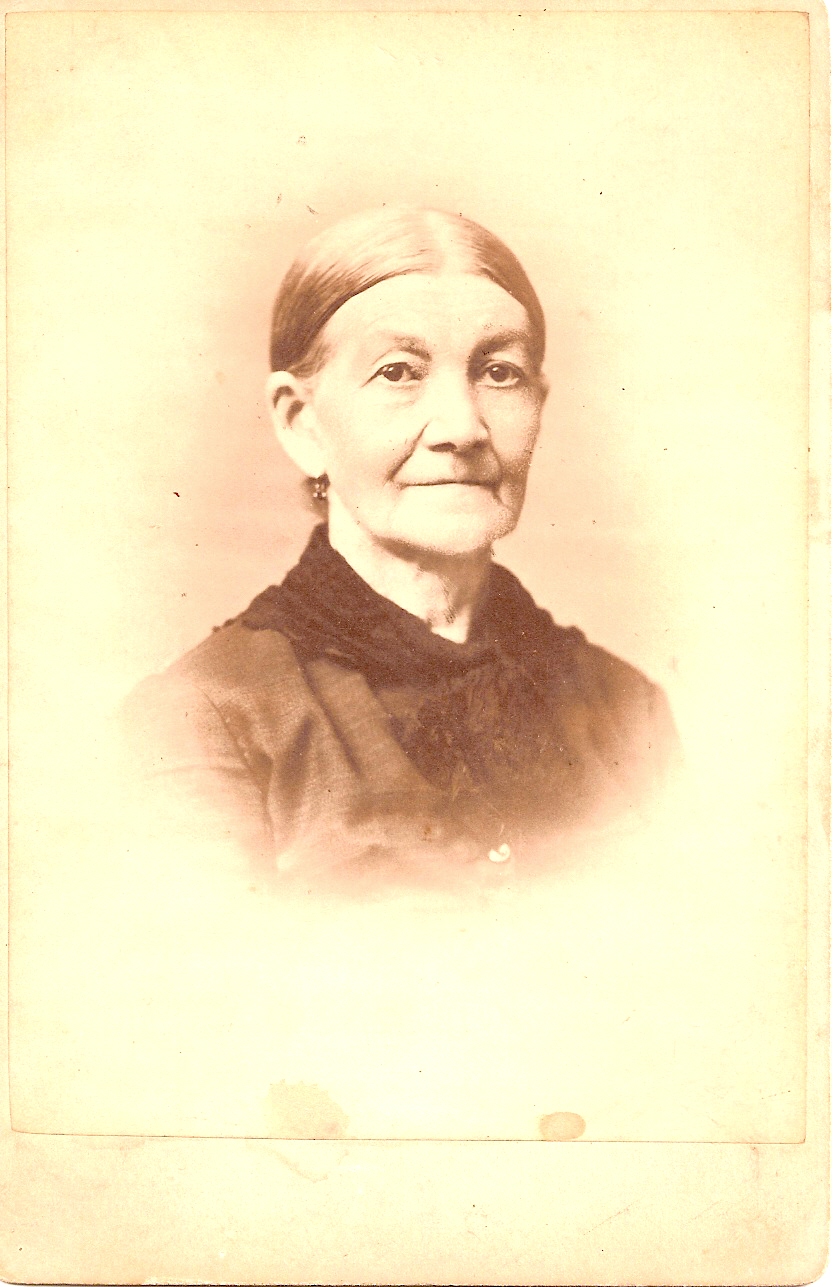
on the reverse of this elegant
Whistler’s-Mother-type old lady’s ancient photo
are three designations in what may be two or
three different hands:
(1) ‘Grandmother Kirchner’
(2) ‘(Mamma’s Mother)’
and (3) ‘Gladys Pund’s great grandmother’
all of which when combined and contemplated
allow us to understand
that this is Marie Kirchner (her married
name) as in the family tree diagram above
who emigrated from Germany to Philadelphia
“about 1800”
(maybe she and John A. came over together –
maybe they met on the boat – maybe they were already married
and that’s why nobody ever wrote down her
maiden name on photos or family trees – maybe, maybe.....)
(or maybe they were cousins and her maiden
name WAS Kirchner – cousins used to marry more than they do
today)
(maybe they were cousins in love and their
families in Alsace
would not let them marry
so they ran away to the New
World together and married here!!!)
(maybe they NEVER MARRIED
and presented themselves to the American
authorities as already having married in Europe!!!!!!!!!!)
(just kidding)
(maybe – .... – never mind)
pious
Chinese
worship their ancestors via sacrifices
pious
Calvinists
commune with God and his saints
(i.e., other church members including family
and ancestors)
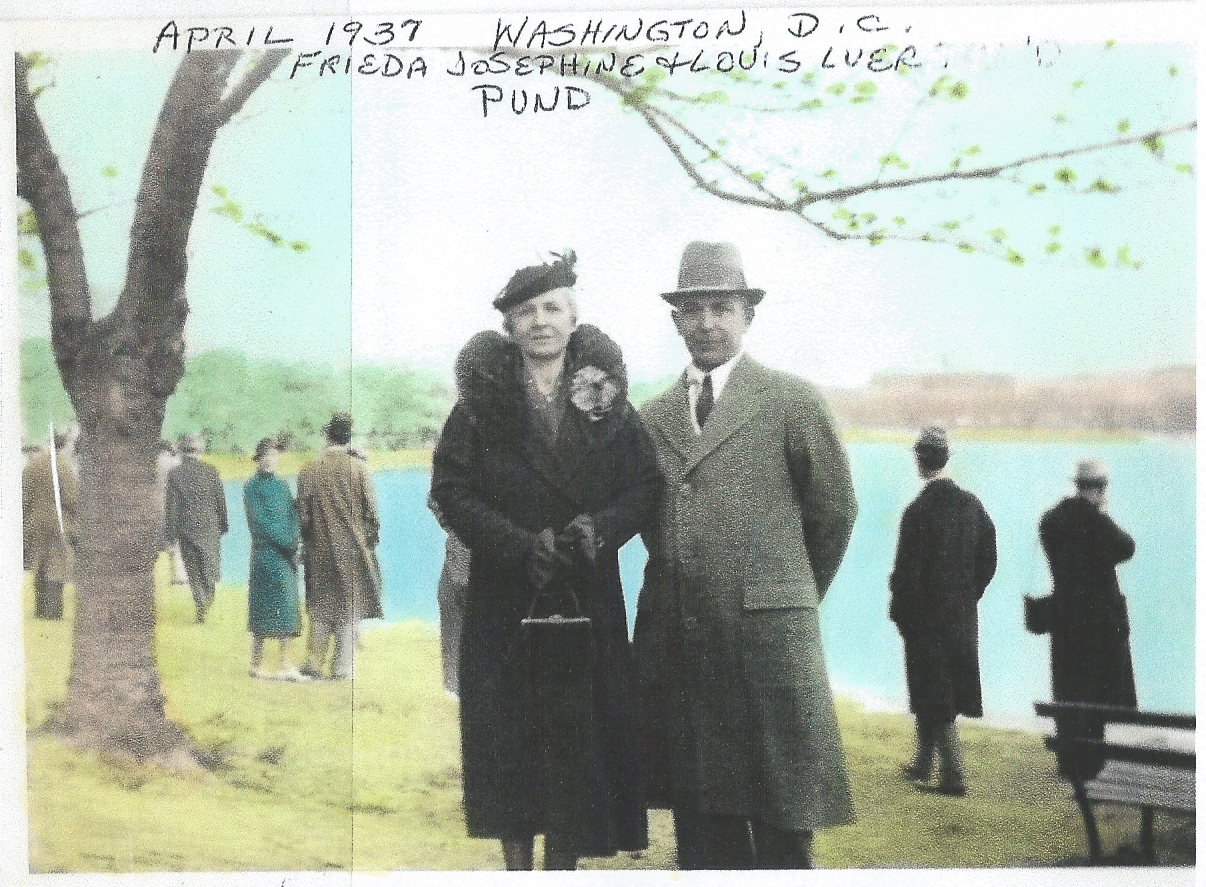
(aren’t they terrific?)
‘Frieda and Louie’
Uncle Eddie’s (and my mother’s) parents in
their early fifties (1937)
within a month of their fourteen-year-old
Eddie’s writing the above autobiography
(aren’t they dazzling?)
Now
therefore, I pray thee, if I have found grace in thy
sight, shew me now thy way, that I may know thee, that
I may find grace in thy sight: and consider that this
nation is thy people.
Exodus 33:13
How
excellent is thy lovingkindness, O God! therefore the
children of men put their trust under the shadow of thy
wings. They shall be abundantly satisfied with the
fatness of thy house; and thou shalt make them drink of
the river of thy pleasures. For with thee is the
fountain of life: in thy light shall we see light.
Psalm 36:7-9
[end of newsletter]
